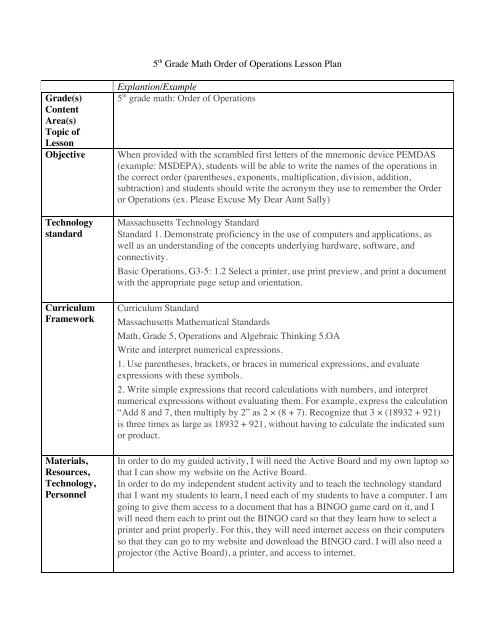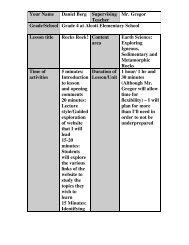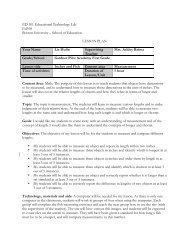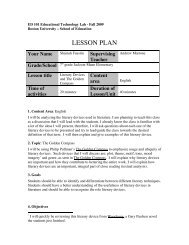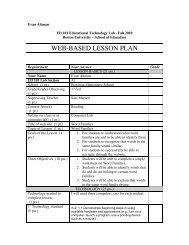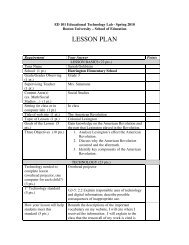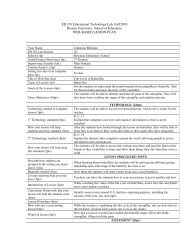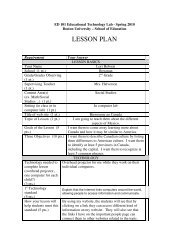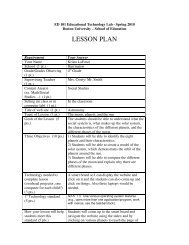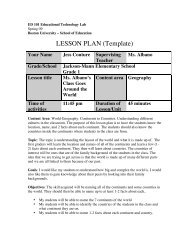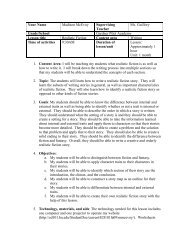5th Grade Math Order of Operations Lesson Plan ... - ED101
5th Grade Math Order of Operations Lesson Plan ... - ED101
5th Grade Math Order of Operations Lesson Plan ... - ED101
Create successful ePaper yourself
Turn your PDF publications into a flip-book with our unique Google optimized e-Paper software.
5 th <strong>Grade</strong> <strong>Math</strong> <strong>Order</strong> <strong>of</strong> <strong>Operations</strong> <strong>Lesson</strong> <strong>Plan</strong><br />
<strong>Grade</strong>(s)<br />
Content<br />
Area(s)<br />
Topic <strong>of</strong><br />
<strong>Lesson</strong><br />
Objective<br />
Technology<br />
standard<br />
Curriculum<br />
Framework<br />
Materials,<br />
Resources,<br />
Technology,<br />
Personnel<br />
Explantion/Example<br />
5 th grade math: <strong>Order</strong> <strong>of</strong> <strong>Operations</strong><br />
When provided with the scrambled first letters <strong>of</strong> the mnemonic device PEMDAS<br />
(example: MSDEPA), students will be able to write the names <strong>of</strong> the operations in<br />
the correct order (parentheses, exponents, multiplication, division, addition,<br />
subtraction) and students should write the acronym they use to remember the <strong>Order</strong><br />
or <strong>Operations</strong> (ex. Please Excuse My Dear Aunt Sally)<br />
Massachusetts Technology Standard<br />
Standard 1. Demonstrate pr<strong>of</strong>iciency in the use <strong>of</strong> computers and applications, as<br />
well as an understanding <strong>of</strong> the concepts underlying hardware, s<strong>of</strong>tware, and<br />
connectivity.<br />
Basic <strong>Operations</strong>, G3-5: 1.2 Select a printer, use print preview, and print a document<br />
with the appropriate page setup and orientation.<br />
Curriculum Standard<br />
Massachusetts <strong>Math</strong>ematical Standards<br />
<strong>Math</strong>, <strong>Grade</strong> 5, <strong>Operations</strong> and Algebraic Thinking 5.OA<br />
Write and interpret numerical expressions.<br />
1. Use parentheses, brackets, or braces in numerical expressions, and evaluate<br />
expressions with these symbols.<br />
2. Write simple expressions that record calculations with numbers, and interpret<br />
numerical expressions without evaluating them. For example, express the calculation<br />
“Add 8 and 7, then multiply by 2” as 2 × (8 + 7). Recognize that 3 × (18932 + 921)<br />
is three times as large as 18932 + 921, without having to calculate the indicated sum<br />
or product.<br />
In order to do my guided activity, I will need the Active Board and my own laptop so<br />
that I can show my website on the Active Board.<br />
In order to do my independent student activity and to teach the technology standard<br />
that I want my students to learn, I need each <strong>of</strong> my students to have a computer. I am<br />
going to give them access to a document that has a BINGO game card on it, and I<br />
will need them each to print out the BINGO card so that they learn how to select a<br />
printer and print properly. For this, they will need internet access on their computers<br />
so that they can go to my website and download the BINGO card. I will also need a<br />
projector (the Active Board), a printer, and access to internet.
<strong>Lesson</strong><br />
Introduction<br />
(5 minutes)<br />
Guided<br />
Activity<br />
(10 – 15<br />
minutes)<br />
I am going to give examples <strong>of</strong> easier math problems that only have one operation in<br />
them (5+6). Then I will say, but what if there is more than one operation? And then<br />
show examples <strong>of</strong> expressions with more than one operation (7+8/4, 3x8+9x7, etc.) I<br />
will ask the class to solve these harder expressions without telling them if they are<br />
right. I’m sure I will collect a bunch <strong>of</strong> different answers because the students will be<br />
confused about which operation they should do first. I will then explain that there is<br />
a method <strong>of</strong> doing these harder problems called PEMDAS. I will explain this to them<br />
by connecting it to cooking a meal. If we have all <strong>of</strong> the different instructions for a<br />
meal, but do them in in the wrong order, our meal isn’t going to taste very good. For<br />
example, if we put the eggs and sugar in the bowl, put it in the oven, and then dump<br />
the flour on the cooked sugar and eggs, our cookies will not taste very good. It is<br />
very important to cook and solve equations in the correct order!<br />
For my guided activity, I am going to go through the review page on PEMDAS. I<br />
will explain that PEMDAS is <strong>of</strong>ten remembered as Please Excuse My Dear Aunt<br />
Sally and give them a couple <strong>of</strong> minutes to come up with their own acronym if they<br />
can think <strong>of</strong> one. They can then share their acronyms with the class. I will also go<br />
over several different <strong>Order</strong> <strong>of</strong> <strong>Operations</strong> problems with them so that they can learn.<br />
I will use the Active Board, so for some problems, I will have the students come up<br />
and show the class how to do the problem in front <strong>of</strong> everyone else to get them more<br />
engaged in the material. If I don’t want them to come up to the board, I will have<br />
them raise their hands and tell me the steps for solving the expressions.<br />
For my activity, the students need to learn how to print correctly. They need to select<br />
a printer, use print preview, and print a document with the appropriate page setup<br />
and orientation. I will show them how to go to my website and download the BINGO<br />
card to their computer. I will then show them how to open the document in a Word<br />
document. I will show them how to go to File and Print. I will choose the correct<br />
printer and print the page. I will then have the kids re-explain back to me how to<br />
print the BINGO card so that I know they will know how to do it when they have<br />
their own computers.<br />
Independent<br />
Student<br />
Activity<br />
(10-15<br />
minutes)<br />
We are going to play <strong>Order</strong> <strong>of</strong> <strong>Operations</strong> BINGO! I am going to create a bunch <strong>of</strong><br />
different BINGO cards for the students on osric.com, which allows you to put in all<br />
<strong>of</strong> the information on the cards, but in different orders on the cards. You do not need<br />
an account for Orsic.com. Anyone can make Bingo cards with anything on them and<br />
use them however they wish. I will then put little papers <strong>of</strong> a bunch <strong>of</strong> different<br />
expressions into a hat. I will pick an expression one at a time and when I call out the<br />
expression, I will write it on the board and have the students write down the<br />
expressions on a piece <strong>of</strong> paper. I will have them write out all <strong>of</strong> their steps to solve<br />
the expression. When they solve the expression and get a number, they can look on<br />
their BINGO card and see if the number is on their card. They can mark the number<br />
with a pen or a pencil. We will do this over and over again until someone gets<br />
BINGO (diagonal, up or down). We can play as many times as we need to fill up the<br />
class period. The kids will start to get really good and fast at solving the expressions<br />
using the correct <strong>Order</strong> <strong>of</strong> <strong>Operations</strong>.
Wrap-Up <strong>of</strong><br />
<strong>Lesson</strong><br />
(Closure)<br />
(5 minutes)<br />
How will<br />
students be<br />
assessed to<br />
make sure they<br />
are able to<br />
perform the<br />
objective?<br />
To wrap up the lesson, I am going to show the students a YouTube video which is a<br />
song about the <strong>Order</strong> <strong>of</strong> <strong>Operations</strong> so that they can get the song stuck in their head<br />
and remember it whenever they need to remember PEMDAS and do an order <strong>of</strong><br />
operations problem. Here is the link to the<br />
video: http://www.youtube.com/watch?v=VvlhJ64ID9Q. I will show it on the Active<br />
Board from my computer. I will play the video 2 or 3 times so that they can learn it<br />
and start to sing along with it.<br />
Objective: When provided with the scrambled first letters <strong>of</strong> the mnemonic device<br />
PEMDAS (example: MSDEPA), students will be able to write the names <strong>of</strong> the<br />
operations in the correct order (parentheses, exponents, multiplication, division,<br />
addition, subtraction) and students should write the acronym they use to remember<br />
the <strong>Order</strong> or <strong>Operations</strong> (ex. Please Excuse My Dear Aunt Sally)<br />
Assessment: After reviewing the website and having time to practice PEMDAS<br />
problems for a couple nights <strong>of</strong> homework or a few class sessions, students will be<br />
provided with a worksheet that has the PEMDAS letters all scrambled up<br />
(MSDEPA) at the top. There will then be three columns on the worksheet. One<br />
column will be for the first letter <strong>of</strong> the mnemonic device (P) in the correct order, the<br />
second column will be what the letter stands for (Parentheses), and the third column<br />
will be for how they remember it (Please).


